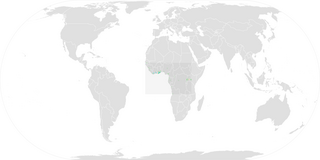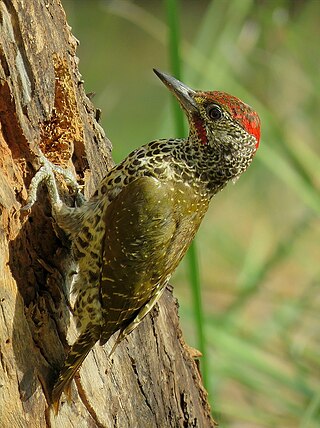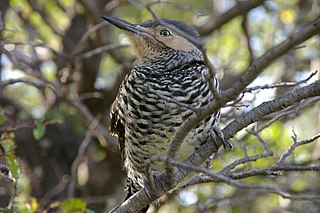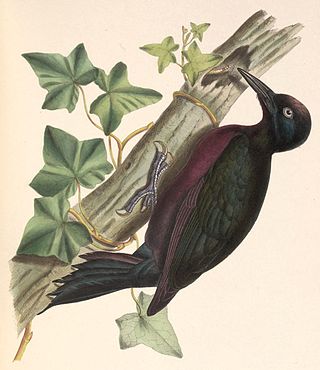
Woodpeckers are part of the bird family Picidae, which also includes the piculets, wrynecks and sapsuckers. Members of this family are found worldwide, except for Australia, New Guinea, New Zealand, Madagascar and the extreme polar regions. Most species live in forests or woodland habitats, although a few species are known that live in treeless areas, such as rocky hillsides and deserts, and the Gila woodpecker specialises in exploiting cacti.

The northern flicker or common flicker is a medium-sized bird of the woodpecker family. It is native to most of North America, parts of Central America, Cuba, and the Cayman Islands, and is one of the few woodpecker species that migrate. Over 100 common names for the northern flicker are known, including yellowhammer, clape, gaffer woodpecker, harry-wicket, heigh-ho, wake-up, walk-up, wick-up, yarrup, and gawker bird. Many of these names derive from attempts to imitate some of its calls. It is the state bird of Alabama.

The Cuban amazon, also known as the Cuban parrot and the rose-throated parrot, is a medium-sized mainly green parrot found in woodlands and dry forests of Cuba, the Bahamas and Cayman Islands in the Caribbean. Although they have been observed in the wild in Puerto Rico, they are probably the result of escaped pets, and no reproduction has been recorded.
The Arabian woodpecker or Sarat woodpecker, is a bird species of the family Picidae, native to the Sarawat Mountains of Saudi Arabia and Yemen. It is the only woodpecker that breeds on the Arabian Peninsula.

The Cuban macaw or Cuban red macaw is an extinct species of macaw native to the main island of Cuba and the nearby Isla de la Juventud. It became extinct in the late 19th century. Its relationship with other macaws in its genus was long uncertain, but it was thought to have been closely related to the scarlet macaw, which has some similarities in appearance. It may also have been closely related, or identical, to the hypothetical Jamaican red macaw. A 2018 DNA study found that it was the sister species of two red and two green species of extant macaws.

The Zapata rail is a medium-sized, dark-coloured rail. It has brown upperparts, greyish-blue underparts, a red-based yellow bill, white undertail coverts, and red eyes and legs. Its short wings render it almost flightless. It is endemic to the wetlands of the Zapata Peninsula in southern Cuba, where its only known nest was found in sawgrass tussocks. Little is known of its diet or reproductive behaviour, and its described calls may belong to a different species.

The bay woodpecker is a species of bird in the family Picidae.

The little green woodpecker, or golden-backed woodpecker, is a species of bird in the family Picidae. It is found in Africa, living in forest edges, clearings, and forest-shrub mosaics. The International Union for Conservation of Nature (IUCN) has assessed it as a least-concern species.

The buff-spotted woodpecker is a species of bird in the family Picidae. It is native to large parts of tropical central Africa. It has an extremely wide range and is an uncommon species, and the International Union for Conservation of Nature has rated its conservation status as being of "least concern".

The Knysna woodpecker is a species of bird in the family Picidae. It is endemic to South Africa, where its natural habitats are subtropical or tropical moist lowland forests, moist savanna, and subtropical or tropical moist shrubland. It is threatened by habitat loss. It belongs to a species complex that includes the golden-tailed and Mombasa woodpeckers.

The black-necked woodpecker or black-necked flicker is a species of bird in subfamily Picinae of the woodpecker family Picidae. It is endemic to Peru.

The campo flicker is a species of bird in subfamily Picinae of the woodpecker family Picidae. It is found in Argentina, Bolivia, Brazil, Paraguay, Suriname, and Uruguay.

The green-barred woodpecker or green-barred flicker is a species of bird in subfamily Picinae of the woodpecker family Picidae. It is found in Argentina, Bolivia, Brazil, Paraguay and Uruguay.

The Chilean flicker is a species of bird in subfamily Picinae of the woodpecker family Picidae. It is found in Argentina and Chile.

The spot-breasted woodpecker or spot-breasted flicker is a species of bird in subfamily Picinae of the woodpecker family Picidae. It is found in Panama and every mainland South American country except Argentina, Chile, Paraguay, and Uruguay.

The Andean flicker is a species of bird in subfamily Picinae of the woodpecker family Picidae. It is found in Argentina, Bolivia, Chile, Ecuador, and Peru.

The Andaman woodpecker is a species of bird in the woodpecker family Picidae. It is endemic to the Andaman Islands in India. Its natural habitat is tropical moist lowland forests. It is threatened by habitat loss.

The Guadeloupe woodpecker or Tapeur is a species of bird in the woodpecker family Picidae belonging to the genus Melanerpes. Endemic to the Guadeloupe archipelago in the Lesser Antilles, it is a medium-sized forest woodpecker with entirely black plumage and red-to-purple reflections on its stomach. It lives mainly in the islands' tropical rainforest areas. The woodpecker has no sexual dimorphism. The species has adapted under the pressure of urbanization to more open forest environments.

The West Indian woodpecker is a species of bird in subfamily Picinae of the woodpecker family Picidae. It is found in the Bahamas, the Cayman Islands and Cuba.

The Cuban green woodpecker is a species of woodpecker in the family Picidae and tribe Melanerpini, known locally in Cuban Spanish as carpintero verde. It is the only species within the genus Xiphidiopicus and is one of two woodpeckers endemic to Cuba. It is the most widespread and common woodpecker in Cuba, inhabiting primarily woodlands, as well as dry and wet forests, pine forests and mangroves. The population of the Cuban green woodpecker is stable and its status is listed as "Least Concern".





















